2008 Seat Ibiza 5D ESP
[x] Cancel search: ESPPage 41 of 260
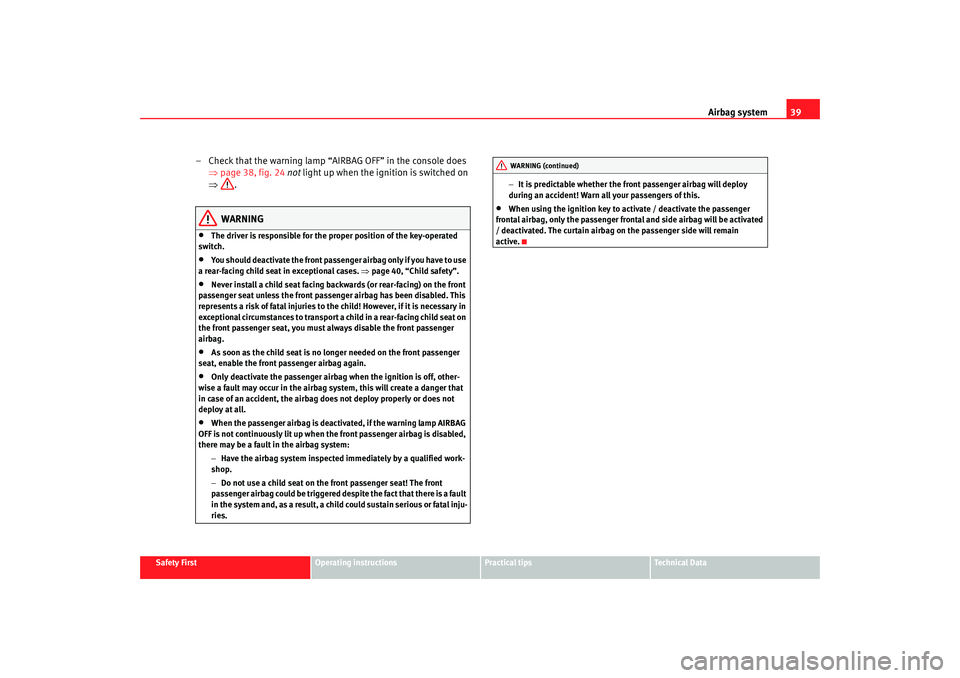
Airbag system39
Safety First
Operating instructions
Practical tips
Te c h n i c a l D a t a
– Check that the warning lamp “AIRBAG OFF” in the console does
⇒page 38, fig. 24 not light up when the ignition is switched on
⇒ .
WARNING
•
The driver is responsible for the proper position of the key-operated
switch.
•
You should deactivate the front passenger airbag only if you have to use
a rear-facing child seat in exceptional cases. ⇒ page 40, “Child safety”.
•
Never install a child seat facing backwards (or rear-facing) on the front
passenger seat unless the front passenger airbag has been disabled. This
represents a risk of fatal injuries to th e child! However, if it is necessary in
exceptional circumstances to transport a child in a rear-facing child seat on
the front passenger seat, you must always disable the front passenger
airbag.
•
As soon as the child seat is no longer needed on the front passenger
seat, enable the front passenger airbag again.
•
Only deactivate the passenger airbag when the ignition is off, other-
wise a fault may occur in the airbag system, this will create a danger that
in case of an accident, the airbag do es not deploy properly or does not
deploy at all.
•
When the passenger airbag is deactivated, if the warning lamp AIRBAG
OFF is not continuously lit up when the front passenger airbag is disabled,
there may be a fault in the airbag system:
−Have the airbag system inspected immediately by a qualified work-
shop.
− Do not use a child seat on the front passenger seat! The front
passenger airbag could be triggered despite the fact that there is a fault
in the system and, as a result, a child could sustain serious or fatal inju-
ries. −
It is predictable whether the front passenger airbag will deploy
during an accident! Warn all your passengers of this.
•
When using the ignition key to activate / deactivate the passenger
frontal airbag, only the passenger frontal and side airbag will be activated
/ deactivated. The curtain airbag on the passenger side will remain
active.WARNING (continued)
Ibiza250_angles Seite 39 Dienstag, 5. August 2008 1:11 13
Page 42 of 260
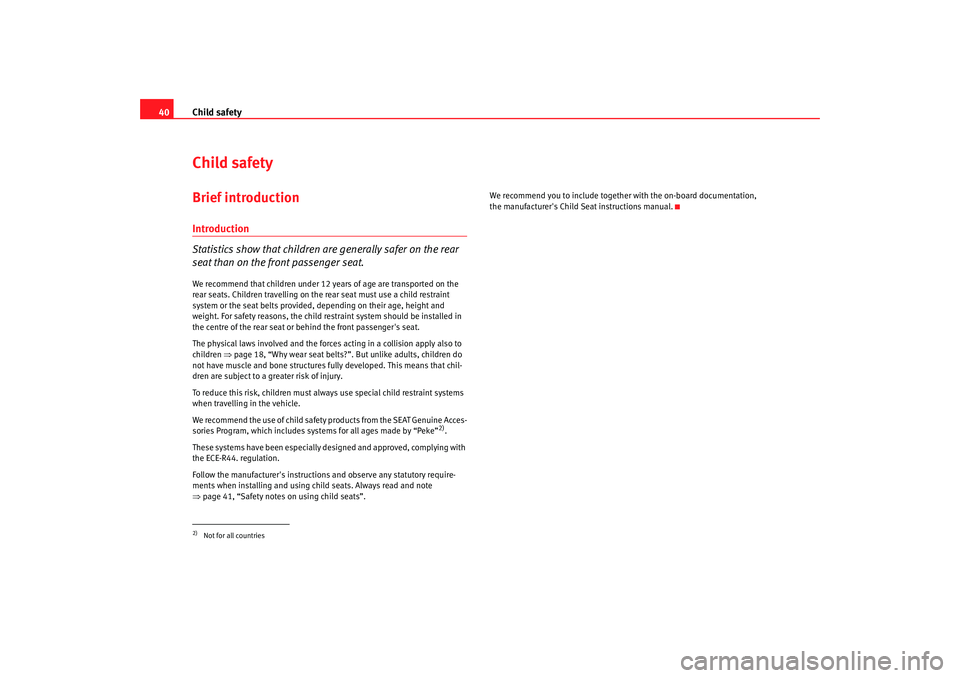
Child safety
40Child safetyBrief introductionIntroduction
Statistics show that children are generally safer on the rear
seat than on the front passenger seat.We recommend that children under 12 years of age are transported on the
rear seats. Children travelling on the rear seat must use a child restraint
system or the seat belts provided, depending on their age, height and
weight. For safety reasons, the child restraint system should be installed in
the centre of the rear seat or behind the front passenger's seat.
The physical laws involved and the forces acting in a collision apply also to
children ⇒page 18, “Why wear seat belts?”. But unlike adults, children do
not have muscle and bone structures fu lly developed. This means that chil-
dren are subject to a greater risk of injury.
To reduce this risk, children must always use special child restraint systems
when travelling in the vehicle.
We recommend the use of child safety products from the SEAT Genuine Acces-
sories Program, which includes systems for all ages made by “Peke”
2).
These systems have been especially designed and approved, complying with
the ECE-R44. regulation.
Follow the manufacturer's instructions and observe any statutory require-
ments when installing and using child seats. Always read and note
⇒ page 41, “Safety notes on using child seats”. We recommend you to include together
with the on-board documentation,
the manufacturer's Child Seat instructions manual.
2)Not for all countries
Ibiza250_angles Seite 40 Dienstag, 5. August 2008 1:11 13
Page 43 of 260
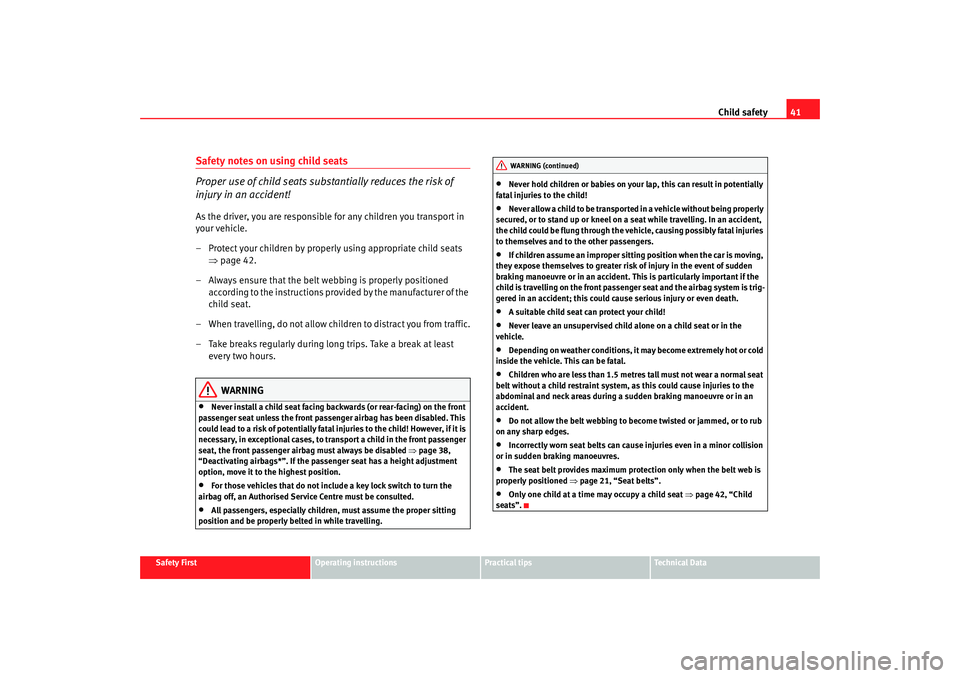
Child safety41
Safety First
Operating instructions
Practical tips
Te c h n i c a l D a t a
Safety notes on using child seats
Proper use of child seats substantially reduces the risk of
injury in an accident!As the driver, you are responsible for any children you transport in
your vehicle.
– Protect your children by properly using appropriate child seats
⇒page 42.
– Always ensure that the belt webbing is properly positioned according to the instructions prov ided by the manufacturer of the
child seat.
– When travelling, do not allow children to distract you from traffic.
– Take breaks regularly during long trips. Take a break at least every two hours.
WARNING
•
Never install a child seat facing backwards (or rear-facing) on the front
passenger seat unless the front passenger airbag has been disabled. This
could lead to a risk of pote ntially fatal injuries to the child! However, if it is
necessary, in exceptional cases, to transport a child in the front passenger
seat, the front passenger airbag must always be disabled ⇒page 38,
“Deactivating airbags*”. If the passe nger seat has a height adjustment
option, move it to the highest position.
•
For those vehicles that do not include a key lock switch to turn the
airbag off, an Authorised Service Centre must be consulted.
•
All passengers, especially children, must assume the proper sitting
position and be properly belted in while travelling.
•
Never hold children or babies on your lap, this can result in potentially
fatal injuries to the child!
•
Never allow a child to be transported in a vehicle without being properly
secured, or to stand up or kneel on a seat while travelling. In an accident,
the child could be flung through the vehicle, causing possibly fatal injuries
to themselves and to the other passengers.
•
If children assume an improper sitting position when the car is moving,
they expose themselves to greater risk of injury in the event of sudden
braking manoeuvre or in an accident. Th is is particularly important if the
child is travelling on the front passenger seat and the airbag system is trig-
gered in an accident; this could cause serious injury or even death.
•
A suitable child seat can protect your child!
•
Never leave an unsupervised child alone on a child seat or in the
vehicle.
•
Depending on weather conditions, it may become extremely hot or cold
inside the vehicle. This can be fatal.
•
Children who are less than 1.5 metres tall must not wear a normal seat
belt without a child restraint system, as this could cause injuries to the
abdominal and neck areas during a sudden braking manoeuvre or in an
accident.
•
Do not allow the belt webbing to become twisted or jammed, or to rub
on any sharp edges.
•
Incorrectly worn seat belts can cause injuries even in a minor collision
or in sudden braking manoeuvres.
•
The seat belt provides maximum protection only when the belt web is
properly positioned ⇒page 21, “Seat belts”.
•
Only one child at a time may occupy a child seat ⇒page 42, “Child
seats”.WARNING (continued)
Ibiza250_angles Seite 41 Dienstag, 5. August 2008 1:11 13
Page 51 of 260
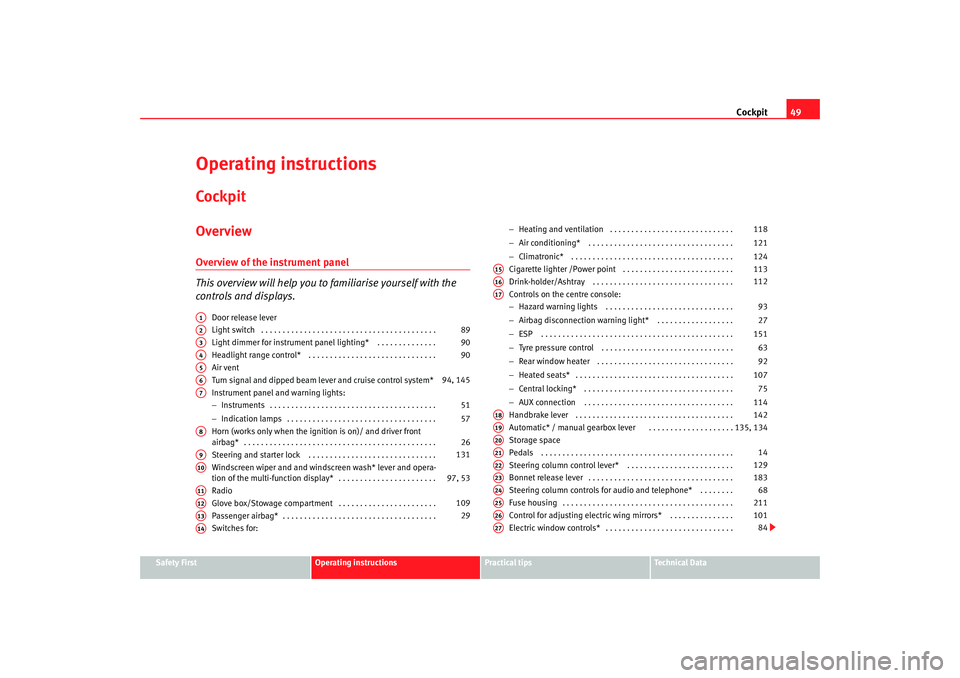
Cockpit49
Safety First
Operating instructions
Practical tips
Te c h n i c a l D a t a
Operating instructionsCockpitOverviewOverview of the instrument panel
This overview will help you to familiarise yourself with the
controls and displays.
Door release lever
Light switch . . . . . . . . . . . . . . . . . . . . . . . . . . . . . . . . . . . . . . . . .
Light dimmer for instrument panel ligh ting* . . . . . . . . . . . . . .
Headlight range control* . . . . . . . . . . . . . . . . . . . . . . . . . . . . . .
Air vent
Turn signal and dipped beam lever and cruise control system*
Instrument panel an d warning lights:
− Instruments . . . . . . . . . . . . . . . . . . . . . . . . . . . . . . . . . . . . . . .
− Indication lamps . . . . . . . . . . . . . . . . . . . . . . . . . . . . . . . . . . .
Horn (works only when the igni tion is on)/ and driver front
airbag* . . . . . . . . . . . . . . . . . . . . . . . . . . . . . . . . . . . . . . . . . . . . .
Steering and starter lock . . . . . . . . . . . . . . . . . . . . . . . . . . . . . .
Windscreen wiper and and windscreen wash* lever and opera-
tion of the multi-function display* . . . . . . . . . . . . . . . . . . . . . . .
Radio
Glove box/Stowage compartment . . . . . . . . . . . . . . . . . . . . . . .
Passenger airbag* . . . . . . . . . . . . . . . . . . . . . . . . . . . . . . . . . . . .
Switches for: −
Heating and ventilation . . . . . . . . . . . . . . . . . . . . . . . . . . . . .
− Air conditioning* . . . . . . . . . . . . . . . . . . . . . . . . . . . . . . . . . .
− Climatronic* . . . . . . . . . . . . . . . . . . . . . . . . . . . . . . . . . . . . . .
Cigarette lighter /Power point . . . . . . . . . . . . . . . . . . . . . . . . . .
Drink-holder/Ashtray . . . . . . . . . . . . . . . . . . . . . . . . . . . . . . . . .
Controls on the centre console:
− Hazard warning lights . . . . . . . . . . . . . . . . . . . . . . . . . . . . . .
− Airbag disconnection warni ng light* . . . . . . . . . . . . . . . . . .
− ESP . . . . . . . . . . . . . . . . . . . . . . . . . . . . . . . . . . . . . . . . . . . . .
− Tyre pressure control . . . . . . . . . . . . . . . . . . . . . . . . . . . . . . .
− Rear window heater . . . . . . . . . . . . . . . . . . . . . . . . . . . . . . . .
− Heated seats* . . . . . . . . . . . . . . . . . . . . . . . . . . . . . . . . . . . . .
− Central locking* . . . . . . . . . . . . . . . . . . . . . . . . . . . . . . . . . . .
− AUX connection . . . . . . . . . . . . . . . . . . . . . . . . . . . . . . . . . . .
Handbrake lever . . . . . . . . . . . . . . . . . . . . . . . . . . . . . . . . . . . . .
A utomatic* / manual gearbox lever
. . . . . . . . . . . . . .
. . . . . .
Storage space
Pedals . . . . . . . . . . . . . . . . . . . . . . . . . . . . . . . . . . . . . . . . . . . . .
Steering column control lever* . . . . . . . . . . . . . . . . . . . . . . . . .
Bonnet release lever . . . . . . . . . . . . . . . . . . . . . . . . . . . . . . . . . .
Steering column controls for audio and telephone* . . . . . . . .
Fuse housing . . . . . . . . . . . . . . . . . . . . . . . . . . . . . . . . . . . . . . . .
Control for adjusting electric wing mirrors* . . . . . . . . . . . . . . .
Electric window controls* . . . . . . . . . . . . . . . . . . . . . . . . . . . . . .
A1A2
89
A3
90
A4
90
A5A6
94, 145
A7
51
57
A8
26
A9
131
A10
97, 53
A11A12
109
A13
29
A14
118
121
124
A15
113
A16
112
A17
93
27
151 63
92
107 75
114
A18
142
A19
135, 134
A20A21
14
A22
129
A23
183
A24
68
A25
211
A26
101
A27
84
Ibiza250_angles Seite 49 Dienstag, 5. August 2008 1:11 13
Page 60 of 260
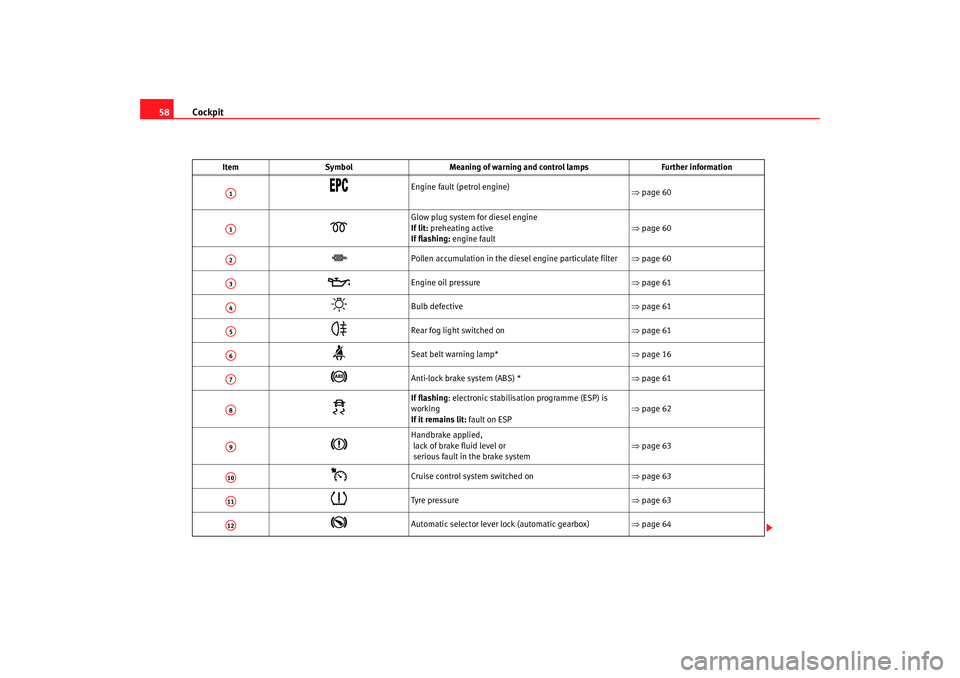
Cockpit
58
Item Symbol Meaning of warning and control lamps Further information
Engine fault (petrol engine)
⇒page 60
Glow plug system for diesel engine
If lit: preheating active
If flashing: engine fault ⇒
page 60
Pollen accumulation in the diesel engine particulate filter ⇒page 60
Engine oil pressure ⇒page 61
Bulb defective ⇒page 61
Rear fog light switched on ⇒page 61
Seat belt warning lamp* ⇒page 16
Anti-lock brake system (ABS) * ⇒page 61
If flashing : electronic stabilisation programme (ESP) is
working
If it remains lit: fault on ESP ⇒
page 62
Handbrake applied,
lack of brake fluid level or
serious fault in the brake system ⇒
page 63
Cruise control system switched on ⇒page 63
Tyre pressure ⇒page 63
Automatic selector lever lock (automatic gearbox) ⇒page 64
A1A1A2A3A4A5A6A7A8A9A10A11A12
Ibiza250_angles Seite 58 Dienstag, 5. August 2008 1:11 13
Page 63 of 260
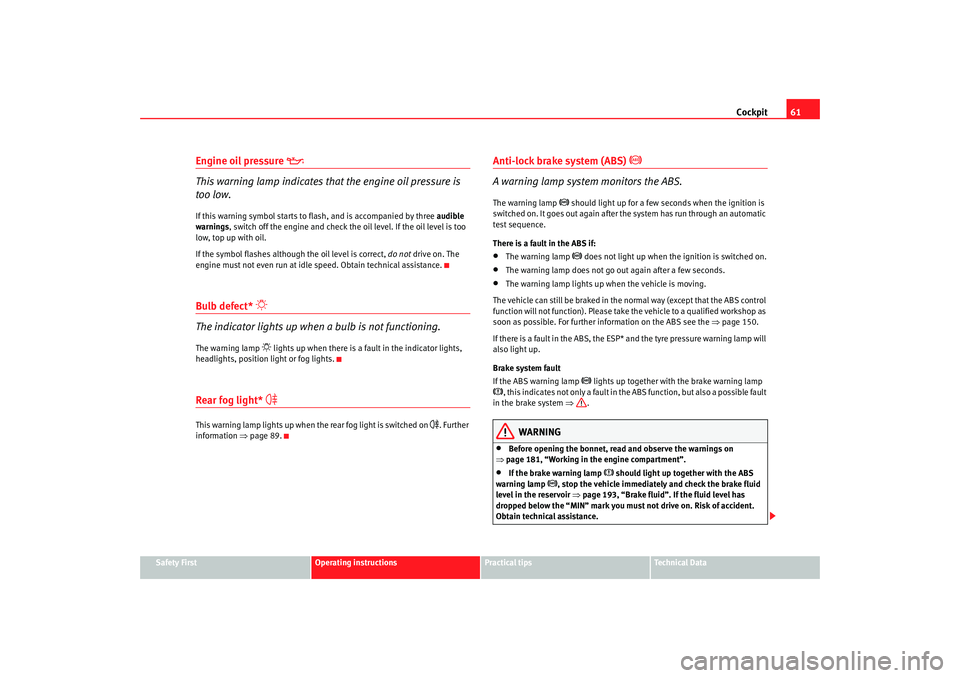
Cockpit61
Safety First
Operating instructions
Practical tips
Te c h n i c a l D a t a
Engine oil pressure
This warning lamp indicates that the engine oil pressure is
too low.If this warning symbol starts to flash, and is accompanied by three audible
warnings , switch off the engine and check the oil level. If the oil level is too
low, top up with oil.
If the symbol flashes although the oil level is correct, do not drive on. The
engine must not even run at idle speed. Obtain technical assistance.Bulb defect*
The indicator lights up when a bulb is not functioning.The warning lamp
lights up when there is a fault in the indicator lights,
headlights, position light or fog lights.
Rear fog light*
This warning lamp lights up when the rear fog light is switched on
. Further
information ⇒page 89.
Anti-lock brake system (ABS)
A warning lamp system monitors the ABS.
The warning lamp
should light up for a few seconds when the ignition is
switched on. It goes out again after th e system has run through an automatic
test sequence.
There is a fault in the ABS if:
•
The warning lamp
does not light up when the ignition is switched on.
•
The warning lamp does not go out again after a few seconds.
•
The warning lamp lights up when the vehicle is moving.
The vehicle can still be braked in the normal way (except that the ABS control
function will not function). Please take the vehicle to a qualified workshop as
soon as possible. For further information on the ABS see the ⇒page 150.
If there is a fault in the ABS, the ESP* and the tyre pressure warning lamp will
also light up.
Brake system fault
If the ABS warning lamp
lights up together with the brake warning lamp
, this indicates not only a fault in the ABS function, but also a possible fault
in the brake system ⇒.
WARNING
•
Before opening the bonnet, read and observe the warnings on
⇒ page 181, “Working in the engine compartment”.
•
If the brake warning lamp
should light up together with the ABS
warning lamp
, stop the vehicle immediately and check the brake fluid
level in the reservoir ⇒page 193, “Brake fluid”. If the fluid level has
dropped below the “MIN” mark you must not drive on. Risk of accident.
Obtain technical assistance.
Ibiza250_angles Seite 61 Dienstag, 5. August 2008 1:11 13
Page 64 of 260
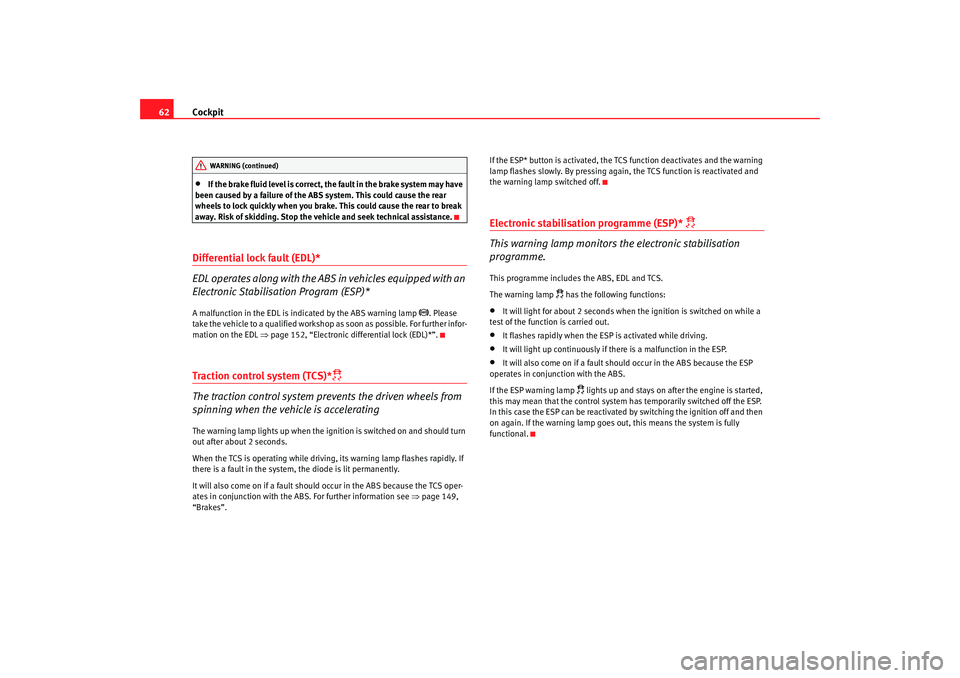
Cockpit
62•
If the brake fluid level is correct, the fault in the brake system may have
been caused by a failure of the ABS system. This could cause the rear
wheels to lock quickly when you brake. This could cause the rear to break
away. Risk of skidding. Stop the vehicle and seek technical assistance.
Differential lock fault (EDL)*
EDL operates along with the ABS in vehicles equipped with an
Electronic Stabilisation Program (ESP)*A malfunction in the EDL is indicated by the ABS warning lamp
. Please
take the vehicle to a qualified workshop as soon as possible. For further infor-
mation on the EDL ⇒page 152, “Electronic differential lock (EDL)*”.
Traction control system (TCS)*
The traction control system prevents the driven wheels from
spinning when the vehicle is acceleratingThe warning lamp lights up when the ignition is switched on and should turn
out after about 2 seconds.
When the TCS is operating while driving, its warning lamp flashes rapidly. If
there is a fault in the system, the diode is lit permanently.
It will also come on if a fault should occur in the ABS because the TCS oper-
ates in conjunction with the ABS. For further information see ⇒page 149,
“Brakes”. If the ESP* button is activated, the TCS function deactivates and the warning
lamp flashes slowly. By pressing again, the TCS function is reactivated and
the warning lamp switched off.
Electronic stabilisation programme (ESP)*
This warning lamp monitors the electronic stabilisation
programme.
This programme includes the ABS, EDL and TCS.
The warning lamp
has the following functions:
•
It will light for about 2 seconds when the ignition is switched on while a
test of the function is carried out.
•
It flashes rapidly when the ESP is activated while driving.
•
It will light up continuously if there is a malfunction in the ESP.
•
It will also come on if a fault should occur in the ABS because the ESP
operates in conjunction with the ABS.
If the ESP warning lamp
lights up and stays on after the engine is started,
this may mean that the control system has temporarily switched off the ESP.
In this case the ESP can be reactivated by switching the ignition off and then
on again. If the warning lamp goes out, this means the system is fully
functional.
WARNING (continued)
Ibiza250_angles Seite 62 Dienstag, 5. August 2008 1:11 13
Page 65 of 260
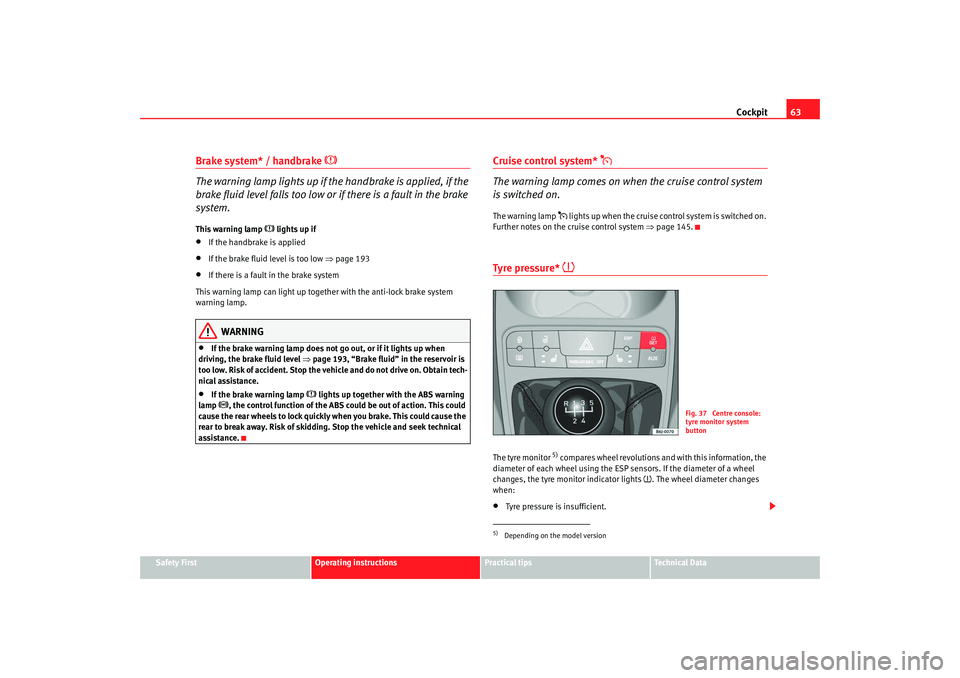
Cockpit63
Safety First
Operating instructions
Practical tips
Te c h n i c a l D a t a
Brake system* / handbrake
The warning lamp lights up if the handbrake is applied, if the
brake fluid level falls too low or if there is a fault in the brake
system.
This warning lamp
lights up if
•
If the handbrake is applied
•
If the brake fluid level is too low ⇒page 193
•
If there is a fault in the brake system
This warning lamp can light up together with the anti-lock brake system
warning lamp.
WARNING
•
If the brake warning lamp does not go out, or if it lights up when
driving, the brake fluid level ⇒ page 193, “Brake fluid” in the reservoir is
too low. Risk of accident. Stop the vehicle and do not drive on. Obtain tech-
nical assistance.
•
If the brake warning lamp
lights up together with the ABS warning
lamp
, the control function of the ABS could be out of action. This could
cause the rear wheels to lock quickly when you brake. This could cause the
rear to break away. Risk of skidding. Stop the vehicle and seek technical
assistance.
Cruise control system*
The warning lamp comes on when the cruise control system
is switched on.The warning lamp
lights up when the cruise control system is switched on.
Further notes on the cruise control system ⇒page 145.
Tyre pressure*
The tyre monitor
5) compares wheel revolutions and with this information, the
diameter of each wheel using the ESP sensors. If the diameter of a wheel
changes, the tyre monitor indicator lights . The wheel diameter changes
when:
•
Tyre pressure is insufficient.
5)Depending on the model version
Fig. 37 Centre console:
tyre monitor system
button
Ibiza250_angles Seite 63 Dienstag, 5. August 2008 1:11 13